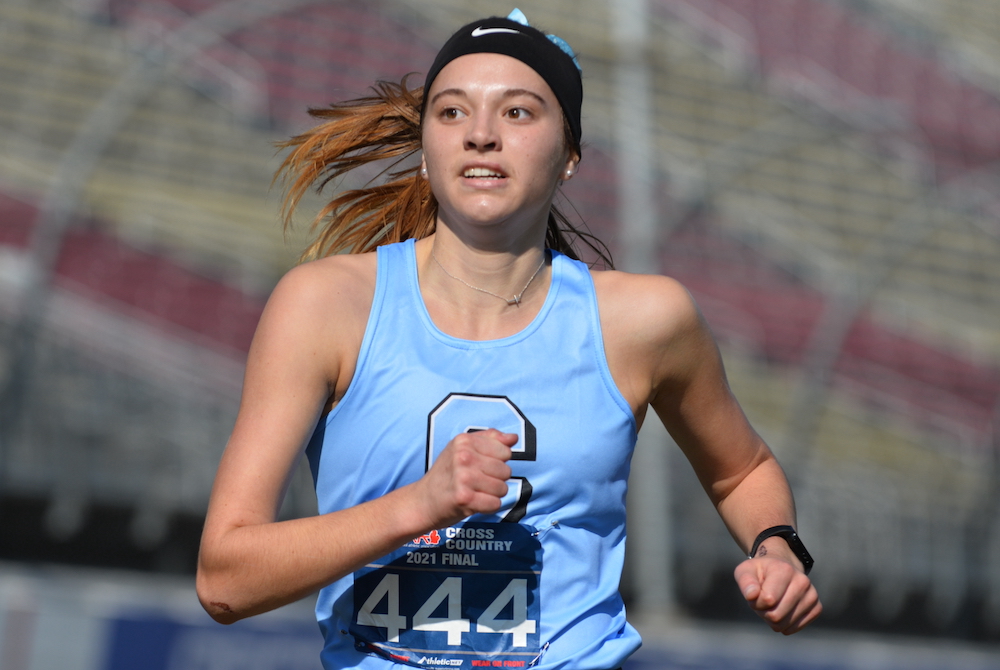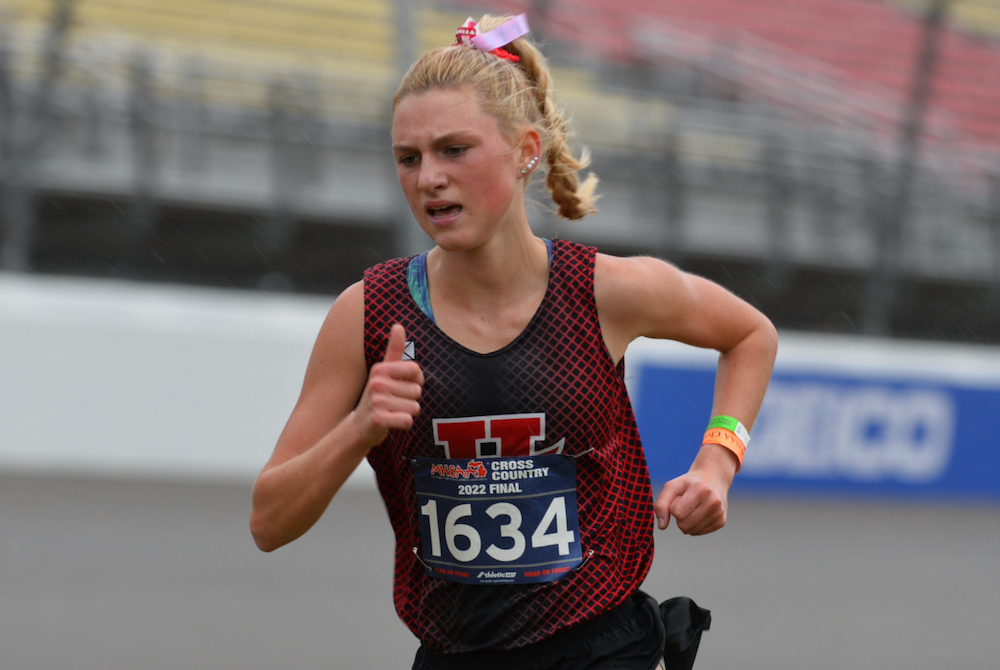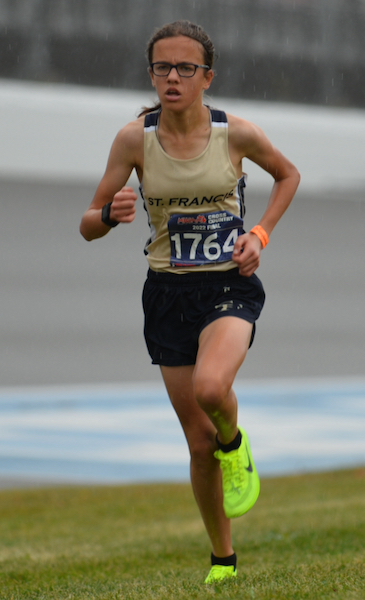
Eagles' Frens, East Grand Rapids Find Fast Gears at Finals Time
November 6, 2021
BROOKLYN — The clock was ticking on Madelyn Frens’ hopes of winning an MHSAA cross country championship in her final season at Grand Rapids Christian.
After running a blistering time of 17:56.0 on Aug. 28 at the Pete Moss Invitational at Benzie Central, Frens was sidelined with a stress reaction in her right femur.
Cross country season is short. Any time away from training and racing makes it less likely a runner will be successful come championship time.
But after going nearly four weeks without a race, Frens returned without missing a beat. With five races as a build-up for the MHSAA Lower Peninsula Division 2 Final, Frens pulled away from a five-way battle for the championship to win in 17:52.30.
The time away from running was actually beneficial for Frens.
 “I was able to have a lot of time just to think about myself and what running actually means to me,” she said. “It doesn’t define all of who I am.”
“I was able to have a lot of time just to think about myself and what running actually means to me,” she said. “It doesn’t define all of who I am.”
It was in her second race back, an Ottawa-Kent Conference White jamboree Oct. 6 that she won in 18:11.9, that Frens knew she was still on track to become a Finals champion.
“I was like, ‘I’ve still got this; my team’s got this,’” Frens said.
Her team finished second with 99 points behind East Grand Rapids, which had 66.
It was the third MHSAA team championship in four years for East Grand Rapids, which took second last year to Petoskey. Grand Rapids Christian was third last year.
East Grand Rapids put four runners in the top 15, with sophomore Drew Muller placing fifth in 18:23.28, senior Ainsley Workman ninth in 18:55.57, freshman Sadey Seyferth 12th in 18:58.41, sophomore Sophia Lado 15th in 19:05.87 and junior Abigail Petr 52nd in 19:50.93. All seven Pioneers broke 20 minutes.
Following Frens across the line were four sophomores who will likely have more battles just like this in the next two years. Early leader Mary Richmond of Frankenmuth was second in 17:56.01, Meghan Ford of Mason was third in 18:10.81, Natalie VanOtteren of Grand Rapids Christian was fourth in 18:13.46 followed by East Grand Rapids’ Muller in 18:23.28. There was a 22-second gap after that before the next wave of runners reached the line.
It was the most competitive race of the day, with five runners within three seconds of one another at the two-mile mark. Frens was fourth at the mile and third at the two mile.
PHOTOS (Top) Grand Rapids Christian’s Madelyn Frens pulls away during the final stretch of Saturday’s LPD2 championship race. (Middle) Drew Muller leads a group of eventual high-placing East Grand Rapids runners in their team title pursuit. (Click for more from RunMichigan.com.)

Jazwinski Brings Hart Individual Title as St. Francis Moves to Front of Team Pack
November 5, 2022
BROOKLYN – Cross country races can be won between the ears before runners ever step foot onto the course.
Attitudes were tested as rain began to descend on Michigan International Speedway and the wind picked up just before the start of the MHSAA Lower Peninsula Division 3 girls race late Saturday morning.
Hart sophomore Jessica Jazwinski was loving life as she prepared to race.
“As a distance runner, I really try to love the wind,” she said. “Distance running and cross country is just a tough sport. The wind just adds to it — and the rain, too. It’s super fun.
“I was just thinking these conditions are just gonna feed my great race. This is real cross country. Yeah!”
Jazwinski overcame the elements to run the fifth-fastest Division 3 time ever, winning with a time of 17:36.70. She has two of the top-five times in Division 3 Finals history, having run 17:31.4 to place third last year.
“Today my race plan was just to go out hard and try to hold on to my pace,” she said. “I feel like I tried to race a lot like Steve Prefontaine, just go out and hold on.”
 Lansing Catholic senior Hannah Pricco was second in 18:17.59, Onsted sophomore Emmry Ross was third in 18:20.96 and Hart junior Alyson Ens was fourth in 18:28.52.
Lansing Catholic senior Hannah Pricco was second in 18:17.59, Onsted sophomore Emmry Ross was third in 18:20.96 and Hart junior Alyson Ens was fourth in 18:28.52.
“I love having great teammates to work with and encourage each other,” Jazwinski said. “We really try to encourage each other so much throughout the races. Throughout this year, some races she’s been a minute behind me, some races she’s been five seconds. I don’t want her to ever beat me, so that pushes me so much. I know she’s trying to race me and get up there with me.”
The only downer for Hart was having its string of Division 3 championships end at five with a fourth-place finish. Hart had two runners in the top four, but its No. 3 runner was 68th.
“I would totally trade my individual title for a team title,” Jazwinski said.
Traverse City St. Francis emerged from a close battle to win its first title since 2016 with 134 points. Pewamo-Westphalia was second with 142 and Lansing Catholic third with 165.
Sophomore Betsy Skendzel led St. Francis, placing seventh in 18:48.33. Completing the team score were senior Sophia Rhein in 26th (19:43.27), sophomore Grace Slocum in 33rd (20:07.95), junior Rylee Duffing in 60th (20:44.82) and junior Margot Hagerty in 63rd (20:45.78).
Lansing Catholic had three place in the top 10, but didn’t get another finisher until 103rd.
PHOTOS (Top) Hart’s Jessica Jazwinski pushes toward the finish during Saturday’s LPD3 Final. (Middle) Traverse City St. Francis’ Betsy Skendzel leads the way for the eventual team champion. (Click for more from Dave McCauley/RunMichigan.com.)

